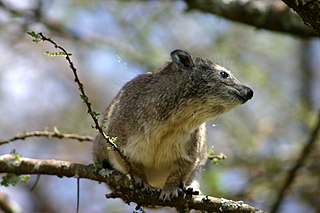
An IUCN Red List Critically Endangered species is one that has been categorized by the International Union for Conservation of Nature as facing an extremely high risk of extinction in the wild. As of 2021, of the 120,372 species currently tracked by the IUCN, there are 8,404 species that are considered to be Critically Endangered.

The Somali hedgehog is a species of mammal in the family Erinaceidae. It is endemic to Somalia and Somaliland. The Somali hedgehog is nocturnal.

The Bornean pygmy shrew is a species of shrew in the family Soricidae. It was named for zoologist Charles Hose.

The southern tree hyrax, also known as the southern tree dassie, is a species of mammal in the family Procaviidae. The southern tree hyrax is mainly found in the south central eastern side of Africa.

The tree hyrax or tree dassie is a small nocturnal mammal native to Africa. Distantly related to elephants and sea cows, it comprises the four species in the genus Dendrohyrax, one of only three genera in the family Procaviidae, which is the only living family within the order Hyracoidea.

The western tree hyrax, also called the western tree dassie or Beecroft's tree hyrax, is a species of tree hyrax within the family Procaviidae. It can be distinguished from other hyraxes by short coarse fur, presence of white patch of fur beneath the chin, lack of hair on the rostrum, and lower crowns of the cheek teeth compared to other members of the same genus.
Notogomphus cottarellii is a species of dragonfly in the family Gomphidae. It is endemic to Ethiopia. Its natural habitats are subtropical or tropical high-altitude grassland and rivers. It is threatened by habitat loss.

Notogomphus is a genus of dragonflies in the family Gomphidae. It contains the following species:
Notogomphus dorsalis is a species of dragonfly in the family Gomphidae. It is found in the Democratic Republic of the Congo, Ethiopia, Kenya, Tanzania, and Uganda. Its natural habitats are subtropical or tropical dry forests, subtropical or tropical moist lowland forests, and rivers.
Notogomphus flavifrons is a species of dragonfly in the family Gomphidae. It is endemic to Uganda. Its natural habitats are subtropical or tropical moist lowland forests and rivers. It is threatened by habitat loss.
Notogomphus kilimandjaricus is a species of dragonfly in the family Gomphidae. It is found in Kenya and Tanzania. Its natural habitats are dry savanna, moist savanna, subtropical or tropical dry shrubland, subtropical or tropical moist shrubland, and rivers.
Notogomphus lecythus is a species of dragonfly in the family Gomphidae. It is found in Ethiopia and Kenya. Its natural habitats are subtropical or tropical moist lowland forests, subtropical or tropical dry shrubland, subtropical or tropical moist shrubland, and rivers.
Notogomphus leroyi is a species of dragonfly in the family Gomphidae. It is found in the Republic of the Congo, the Democratic Republic of the Congo, Kenya, Tanzania, and Uganda. Its natural habitats are subtropical or tropical moist lowland forests and rivers.
Notogomphus lujai is a species of dragonfly in the family Gomphidae. It is found in the Republic of the Congo, the Democratic Republic of the Congo, Kenya, Tanzania, and Uganda. Its natural habitats are subtropical or tropical moist lowland forests and rivers.
Notogomphus maathaiae, commonly known as Maathai’s longleg, is a species of dragonfly in the clubtail family Gomphidae. It is thought to be endemic montane streams in Kenya. The species is considered endangered because the continued destruction of its montane forest habitat by humans creates a very high risk of extinction in the near future.

Notogomphus praetorius is a species of dragonfly in the family Gomphidae; common names include yellowjack, southern yellowjack and yellowjack longlegs.
Notogomphus ruppeli is a species of dragonfly in the family Gomphidae. It is endemic to Ethiopia. Its natural habitats are subtropical or tropical dry forests and rivers. It is threatened by habitat loss.

Notogomphus zernyi is a species of dragonfly in the family Gomphidae. It is found in the Democratic Republic of the Congo, Malawi, Mozambique, Tanzania, and Zimbabwe. Its natural habitats are subtropical or tropical moist lowland forests, moist savanna, subtropical or tropical dry shrubland, subtropical or tropical moist shrubland, and rivers.

The eastern tree hyrax is a species of mammal within the family Procaviidae. The eastern tree hyrax is the most localized of the tree hyrax species, distributed patchily in a narrow band of lowland and montane forests in Kenya and Tanzania and adjacent islands.








